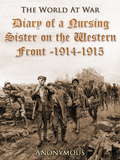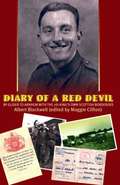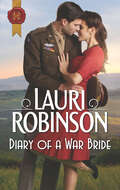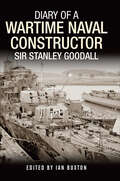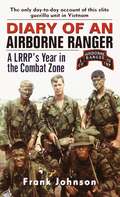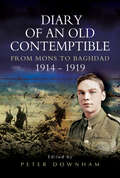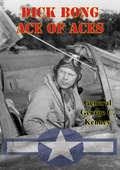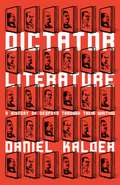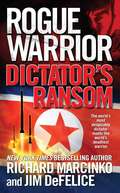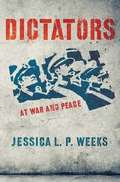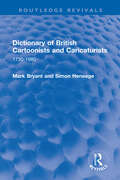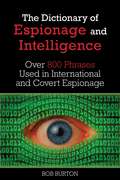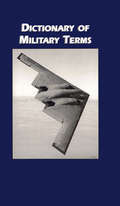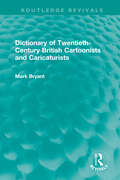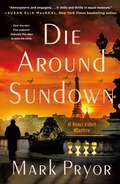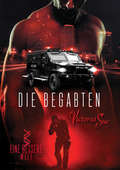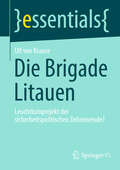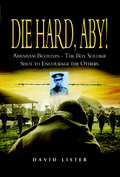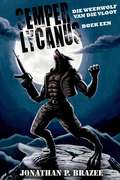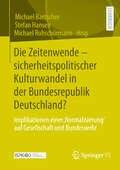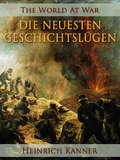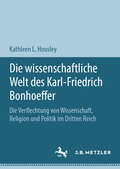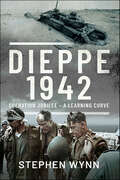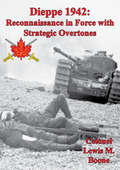- Table View
- List View
Diary of a Nursing Sister on the Western Front, 1914-1915: 1914-1915 (The World At War)
by Anonymous AnonymousExcerpt from book: “Friday, December 18th, 10.30 A.M.--We've had an all-night journey to Rouen, and have almost got there. One of my sitting-ups was 106° this morning, but it was only malaria, first typical one I have met since S.A. A man who saw the King when he was here said, "They wouldn't let him come near the trenches; if a shell had come and hit him I think the Army would 'a gone mad; there'd be no keeping 'em in the trenches after that."
Diary of a Red Devil: By Glider to Arnhem with the 7th King’s Own Scottish Borderers
by Albert BlockwellMany books have been written about the Second World War and the majority of them either concentrate on a particular battle, campaign or unit. Individual accounts are certainly in a minority and those from the lower ranks even more scarcer. Helion and Co Ltd are therefore pleased to announce the publication of Diary of A Red Devil. It relates the war time experiences of a young man, Albert Blockwell from the northeast of England, who in February 1940 was called up for service with the Army. Initially conscripted into the Royal Army Ordnance Corps and trained as a vehicle mechanic, he was then posted in March 1940 to a prewar Territorial unit - The 7th Kings Own Scottish Borderers, then a home defense unit based near London. His diary is a most interesting account of a young vehicle mechanic who also had to learn to be a infantry soldier. Albert remained with this unit for all his wartime service, later going to the Shetland Islands when the 7th KOSB were part of OSDEF (Orkney and Shetlands Defence Force). Then in late 1943 much to their surprise the unit was posted to Lincolnshire to become the third infantry unit in the 1st Airlanding Brigade then in the process of returning from Italy with the rest of the 1st Airborne Division. Swapping their glengarries for red berets Albert and his comrades had to adapt to their new way of getting to war by glider. The diary continues with a down to earth account of the highs and lows of the next few months. Then in September 1944 Albert flew to Holland on Operation Market-Garden and his account (written in PoW camp) describes the savage nine days fighting at Arnhem from the slit trench level. Taken prisoner on the last day his account then describes the spartan life in PoW camp without pulling any punches. Sadly Albert died in 2001 but his diary survived and his daughter Maggie Clifton together with help from two published 'Arnhem' authors have edited a unique account of the fighting at Arnhem from the front-line soldier's perspective. Key sales points: Unique personal account of the formation of Britain's airborne forces and their epic actions during Operation Market Garden, The diary is supplemented by extensive annotations from acknowledged Arnhem expert Niall Cherry providing additional information relating to the units and individuals mentioned in Albert's diary, Features a large number of rare photographs and documents.
Diary of a War Bride
by Lauri Robinson“One word sums this book up for me; Magnificent! . . . this is right up there with the best war romances I have read . . . Just stunning!” —Chicks, Rogues and ScandalsJuly 1942Dear diary, despite the war raging around me, I find I can’t stop thinking about the American officer, Sergeant Dale Johnson. I’ve never known anyone as brave, kind and handsome! But I promised myself I wouldn’t care this much about a man again, especially when he could be transferred at any time. Yet that only makes me want to relish our time together. Now fighting my heart feels like the biggest battle . . .“An excellent WWII romance that is both sweet and well-researched. This book was a delight to read.” —Romantic Parvenu
Diary of a Wartime Naval Constructor: Sir Stanley Goodall
by Ian BuxtonOne of the most significant warship designers of the twentieth century, Sir Stanley Goodall rose through the ranks of the Royal Corps of Naval Constructors to become its head in 1936. The Corps was responsible for every aspect of the design and construction of British warships, and its head, the Director of Naval Construction, was the principal technical advisor to the Board of Admiralty. Although Goodall was succeeded in this post in January 1944, he remained the Assistant Controller Warship Production until October 1945 so was probably the single most influential figure in British naval technical matters during the war years. His private diary was never intended for publication – indeed it seems to have been a vehicle for venting some of his professional frustrations – so his opinions are candid and unrestrained. His criticisms of many in the Admiralty and the shipyards are enlightening, and taken as a whole the diary provides new and unique insights into a wartime construction program that built nearly a thousand major warships and a myriad of landing craft and coastal forces. Dr Ian Buxton, a well-known authority on British shipbuilding, has edited the entries covering Goodall’s war years, identifying the various personalities and ships referred to (sometimes cryptically), while setting out the context in a number of introductory essays. As an insider’s view of a complex process, this book offers every warship enthusiast much new material and a novel perspective on an apparently familiar subject.
Diary of an Airborne Ranger: A LRRP's Year in the Combat Zone
by Frank JohnsonPerhaps the most accurate story of LRRPs at war ever to appear in print! When Frank Johnson arrived in Vietnam in 1969, he was nineteen, a young soldier untested in combat like thousands of others--but with two important differences: Johnson volunteered for the elite L Company Rangers of the 101st Airborne Division, a long range reconnaissance patrol (LRRP) unit, and he kept a secret diary, a practice forbidden by the military to protect the security of LRRP operations. Now, more than three decades later, those hastily written pages offer a rare look at the daily operations of one of the most courageous units that waged war in Vietnam. Johnson served in I Corps, in northern Vietnam, where combat was furious and the events he recounts emerge, stark and compelling: walking point in the A Shau Valley, braving enemy fire to rescue a downed comrade, surviving days and nights of relentless tension that suddenly exploded in the blinding fury of an NVA attack. Undimmed and unmuddied by the passing of years, Johnson's account is unique in the annals of Vietnam literature. Moreover, it is a timeless testimony to the sacrifice and heroism of the LRRPs who dared to risk it all.
Diary of an Old Contemptible: From Mons to Baghdad 1914–1919 Private Edward Roe, East Lancashire Regiment
by Peter Downham&“First class . . . a book that helps the reader to understand just what the ordinary soldier thought about his lot in the Great War.&” —The Western Front Association This is a most unusual chronicle of the events of one man during the Great War. A professional soldier at the outbreak, Edward Roe was one of the first to cross over to France in 1914 and as such fought in the early battles of the war and took part in the Retreat from Mons. He was there for the crossing of the Marne and Aisne, the dreadful fighting at Ploegsteert and for the extraordinary events during the first Christmas. Remarkably he witnessed the debacle at Gallipoli and was part of the rear-guard of the Army during the re-embarkation and evacuation of the Peninsula. Thereafter the scene shifts to Mesopotamia and the Tigris Corps in the attempt to relieve General Townshend at Kut. Wounded he returned for the final campaign that captured Baghdad.&“The author of these unique and extraordinarily moving diaries, which are supported by excellent maps and footnotes, was Edward Roe, an Irishman who had already served nine years with the British Army by the outbreak of the first world war.&” —The Times
Dick Bong: Ace Of Aces
by General George C. KenneyMajor Richard "Dick" Ira Bong died at the tender age of 24 on the 6th August 1945 in a flight accident during testing of the P-80 Shooting Star Fighter. His fame was such that news of his death vied with the atomic bomb attack on Hiroshima in the US press, his legendary exploits at the helm of his P-38 Lightning had made him a household name. Bong had only recently received the Congressional Medal of Honor for his exploits of downing 40 enemy Japanese planes in the Southwestern Pacific. His tally of 40 victories made him the highest scoring American ace of all time, a record that is unlikely to ever be broken.In this biography his former commanding officer General George C. Kenney recounts his life; from his early life in Wisconsin, his sweetheart Marge, and his aerial exploits. Kenney enriches the narrative with personal anecdotes that illuminate the modest unassuming but determinedly heroic, Ace of Aces.Highly recommended.
Dictator Literature: A History of Bad Books by Terrible People
by Daniel KalderA Book of the Year for The Times and the Sunday Times &‘The writer is the engineer of the human soul,&’ claimed Stalin. Although one wonders how many found nourishment in Turkmenbashi&’s Book of the Soul (once required reading for driving tests in Turkmenistan), not to mention Stalin&’s own poetry. Certainly, to be considered great, a dictator must write, and write a lot. Mao had his Little Red Book, Mussolini and Saddam Hussein their romance novels, Kim Jong-il his treatise on the art of film, Hitler his hate-filled tracts. What do these texts reveal about their authors, the worst people imaginable? And how did they shape twentieth-century history? To find out, Daniel Kalder read them all – the badly written and the astonishingly badly written – so that you don&’t have to. This is the untold history of books so terrible they should have been crimes.
Dictator's Ransom (Rogue Warrior #14)
by Richard Marcinko Jim DefeliceWhen Kim Jong II invites the Rogue Warrior to visit North Korea, Dick Marcinko politely declines, wary of what could be in store for him inside the "Hermit Kingdom." But the CI has other ideas and soon Marcinko is enjoying the comforts of the Supreme Leader's palace--where four nuclear warheads may be hidden. Hot on the radioactive trail in a special op, Marcinko has to stay one step ahead of Kim Jong II--and the Russian mobsters he meets on the way.
Dictators at War and Peace
by Jessica L. WeeksWhy do some autocratic leaders pursue aggressive or expansionist foreign policies, while others are much more cautious in their use of military force? The first book to focus systematically on the foreign policy of different types of authoritarian regimes, Dictators at War and Peace breaks new ground in our understanding of the international behavior of dictators. Jessica L. P. Weeks explains why certain kinds of regimes are less likely to resort to war than others, why some are more likely to win the wars they start, and why some authoritarian leaders face domestic punishment for foreign policy failures whereas others can weather all but the most serious military defeat. Using novel cross-national data, Weeks looks at various nondemocratic regimes, including those of Saddam Hussein and Joseph Stalin; the Argentine junta at the time of the Falklands War, the military government in Japan before and during World War II, and the North Vietnamese communist regime. She finds that the differences in the conflict behavior of distinct kinds of autocracies are as great as those between democracies and dictatorships. Indeed, some types of autocracies are no more belligerent or reckless than democracies, casting doubt on the common view that democracies are more selective about war than autocracies.
Dictionary of British Cartoonists and Caricaturists: 1730-1980 (Routledge Revivals)
by Mark Bryant Simon HeneageOriginally published in 1994, this dictionary provides a unique 'who’s who' of the major figures in the world of British cartoons and caricatures. It was the first book to encompass the entire field from c.1730 when Hogarth published the first of his 'modern moral pictures' to 1980. In addition to describing the careers and achievements of the artists and the characteristics of their styles, more than 500 entries give details of their publications, their illustrations to books and periodicals, exhibitions of their work, public collections in which their work is represented and literature on or referring to them. More than 150 illustrations are included. This is a comprehensive reference work and will be of interest to social and political historians as well as cartoon and caricature enthusiasts.
Dictionary of Espionage and Intelligence: Over 800 Phrases Used in International and Covert Espionage
by Bob Burton W. E. GriffinFrom Bob Burton - a former member of both the civilian and military intelligence communities and America’s most feared bounty hunter - comes the complete lexicon of over 800 terms and meanings used in international and covert espionage. Dictionary of Espionage and Intelligence includes the most up-to-date terminology of special operations from A to Z, including: Breaktime: The time it takes to break down he resistance level of a subject in an interrogation of a brutal nature - usually 5-7 hours Hero Project: A project, operation, or extraction considered too dangerous, with only the most skilled personnel able to pull it off. Cake or Death: An unspoken but soon-realized ultimatum that a prisoner of the spook war understands as his personal fate - cooperate or die.Compiled by a man who knows covert action and clandestine warfare from the inside out, Dictionary of Espionage and Intelligence is a perfect compendium of the secret language spoken by those who fight the silent war.
Dictionary of Military Terms: Over 6,000 Words Clearly Defined (Dictionaries Ser.)
by Richard BowyerFirst Published in 2000. Routledge is an imprint of Taylor & Francis, an informa company.
Dictionary of Twentieth-Century British Cartoonists and Caricaturists (Routledge Revivals)
by Mark BryantBritish cartoonists and caricaturists are renowned worldwide. Originally published in 2000, this indispensable handbook offers a unique ‘who’s who’ of all the major artists working in Britain in the twentieth century and contains nearly 500 entries. Extensively illustrated, the book provides information on the work of artists such as Steve Bell, Gerald Scarfe, Posy Simmonds, Ronald Searle, Trog, mac and Larry as well as such past masters as David Low, Vicky, H. M. Bateman, Illingworth, Heath Robinson and more. The dictionary concentrates primarily on political cartoonists, caricaturists and joke or ‘gag’ cartoonists, actively working for the main Fleet Street national dailies and weeklies from 1900 to 1995. Each entry is cross-referenced and provides a concise biographical outline with an account of the artist’s style, influences and preferred medium. Where relevant the entry includes suggestions for further reading and notes solo exhibitions, books illustrated and works held in public collections. The Dictionary of Twentieth-Century British Cartoonists and Caricaturists offers an insight into the lives of satirical artists working during a century that provoked cartoonists and caricaturists to a pitch of comic and artistic invention that has rarely been matched.
Die Around Sundown: A Henri Lefort Mystery (Henri Lefort Mysteries #1)
by Mark PryorMark Pryor's Die Around Sundown is the first entry in an exciting mystery series set in Paris during World War II, where a detective is forced to solve a murder while protecting his own secrets.Summer 1940: In German-occupied Paris, Inspector Henri Lefort has been given just five days to solve the murder of a German major that took place in the Louvre Museum. Blocked from the crime scene but given a list of suspects, Henri encounters a group of artists, including Pablo Picasso, who know more than they're willing to share. With the clock ticking, Henri must uncover a web of lies while overcoming impossible odds to save his own life and prove his loyalty to his country. Will he rise to the task or become another tragic story of a tragic time?Five days. One murder. A masterpiece of a mystery.
Die Begabten (Eine bessere Welt #1)
by Victoria SueEine bessere Welt: Buch EinsAls Talon Valdez zu einem Begabten wurde, wusste er, dass es mit seinem Leben und seinen Träumen vorbei war. Geschmäht, mit Misstrauen betrachtet und häufig eingesperrt wurden diese Menschen mit besonderen Fähigkeiten von der Öffentlichkeit verachtet und als Monster gesehen, denen man niemals so weit trauen konnte, dass sie für das Militär oder als Gesetzeshüter arbeiten durften. Dann bietet sich ihm Jahre später die Gelegenheit, eine Sondereinheit von Begabten aufzubauen, die das FBI unterstützen soll. Die Bedingung dafür ist jedoch, dass jedem Begabten ein normaler Mensch als Partner zugeteilt wird. Finn Mayer träumte seit seinem vierzehnten Lebensjahr von einer Karriere beim FBI und brachte jedes nur mögliche Opfer, um den Traum wahr zu machen, auch wenn er dafür seine selbstsüchtige Mutter und seinen homophoben, tyrannischen Bruder ertragen und auf einen Freund verzichten musste. Doch seine nicht diagnostizierte Dyslexie durchkreuzt diesen Plan. Seine letzte Chance ist die Zusammenarbeit mit Talon, einem Begabten mit einer tödlichen Fähigkeit, der normalen Menschen nicht traut und Finn scheitern sehen möchte. Ihm bleiben vier Wochen, um sich dem Team zu beweisen. Dem Team bleiben vier Wochen, um sich der Öffentlichkeit zu beweisen. Und als eine andere Gruppierung ihren Erfolg – und sie selbst – in Gefahr bringt, müssen sie vier Wochen lang um ihr Leben kämpfen.
Die Brigade Litauen: Leuchttumprojekt der sicherheitspolitischen Zeitenwende? (essentials)
by Ulf von KrauseDieses essential analysiert die geplante dauerhafte Stationierung einer Brigade der Bundeswehr in Litauen, die vom Verteidigungsministerium als "Leuchtturmprojekt der von Bundeskanzler Olaf Scholz ausgerufenen sicherheitspolitischen Zeitenwende" beschrieben wird. Es ordnet das Projekt in den Zusammenhang der Reaktionen der NATO auf den Angriffskrieg Russlands auf die Ukraine und die Bedrohung gegenüber NATO-Staaten ein und zeigt auf, dass dadurch die Abschreckung und die Rolle Deutschlands im Bündnis erheblich gestärkt werden können. Das essential resümiert, dass ein Scheitern des Projekts aufgrund von Risiken, die aus einem spontanen Entscheidungsgang folgen, erhebliche außen- und innenpolitische negative Folgen nach sich ziehen würde.
Die Hard, Aby!: Abraham Bevistein - The Boy Soldier Shot to Encourage the Others
by David ListerRecent books, many by Pen and Sword, such as Shot At Dawn have highlighted the shocking cases of young British soldiers in the Great War being executed by their own side. All too often their trials were cursory and the evidence flimsy. This scandal has appalled right-minded people of all political persuasions. This book examines in depth the case of a young Jewish boy, Aby Beverstein who enlisted in the Middlesex Regiment. Aby was wounded, hospitalized and on (possibly premature) release did not return to his battalion immediately. The authorities arrested and tried him.His execution was greeted with horror by his family and those who knew him and readers will feel equally outraged.
Die Weerwolf van die vloot
by Elaine Jonathan P. BrazeePrivaat Eerste klas Aiden Kaas het by die Mariene aangesluiot vir al die verkeerde redes. Na ontplooing na Irak op negentien, wou hy net sy toer klaar maak. Maar nadat hy deur 'n waarskynlike mal majuhideen gebyt is, ly hy aan 'n seldsame siekte , een met nagevolge wat hy nie in sy woldse drome sou kon voorspel nie. En die siekte het hom aan groter gevare bloodgestel as wat sy onplooing ooit kon. Aiden besef wat dit beteken om 'n man te word, en hoe hy tot verhaal moet kom met wat hy geword het. Waarskuwing: Boek bevat dele met geweld en seks.
Die Zeitenwende – sicherheitspolitischer Kulturwandel in der Bundesrepublik Deutschland?: Implikationen einer ,Normalisierung' auf Gesellschaft und Bundeswehr
by Stefan Hansen Michael Bartscher Michael RohschürmannNach dem russischen Angriffskrieg auf die Ukraine und der ausgerufenen Zeitenwende erkennt die deutsche Gesellschaft mehrheitlich die Notwendigkeit eines bedrohungsgerechten Fähigkeitsaufwuches der deutschen Streitkräfte an. Die Friedensdividende ist aufgebraucht, der Pazifismus offenbar gescheitert, die Zivilmachtrolle überholt - findet in Deutschland somit ein sicherheitspolitischer Kulturwandel statt? Der vorliegende Band vereint Entscheidungsträger sowie Expertinnen und Experten aus unterschiedlichen Fachrichtungen, um zunächst die dramatisch veränderte sicherheitspolitische Lage aufzuzeigen und sodann die Beziehung der deutschen Gesellschaft zu ihren Streitkräften, die Veteranenkultur und -politik im Vergleich zu anderen Nationen sowie die Auswirkungen der Zeitenwende auf die Bundeswehr als Ganzes, aber auch auf den einzelnen Soldaten zu untersuchen.
Die leisen Stimmen der Vernunft: Tonaufnahmen im Schlachthaus der Geschichte
by Peter Schulz-HageleitGeschichte als Abfolge von Massentötungen aller Art und – im Gegensatz dazu – Geschichte als Konzert von leisen Stimmen, die den Frieden beschwören und Vernunft anmahnen: das sind zwei Leitmotive des Buches, die in verschiedenen Inhaltsvariationen thematisiert werden. Dabei finden die grauenhaften Tatsachen der Geschichte ebenso Berücksichtigung wie die kognitiv-emotionale Schwierigkeit, im historisch-politischen Schlachthaus-Geschehen (Kriege, Völkermorde) nicht die Augen zu verschließen, sondern vielmehr standzuhalten und existenziell für eine bessere Welt einzutreten.Was zur Zeit der ersten Auflage des Buches (2006) weit entfernt von realgeschichtlichen Möglichkeiten zu liegen schien, ein imperialistischer Eroberungskrieg, ist seit Februar 2022 bedrückende Wirklichkeit. Die veränderte weltpolitische Konstellation entwertet die früheren Reflexionen und Recherchen nicht, sondern taucht die Befunde in ein noch grelleres Licht.Das Buch wendet sich nicht nur an Personen, die Geschichte professionell erarbeiten und vermitteln, sondern an alle, die im Verhältnis zur Geschichte, wie es medienwirksam präsentiert und zelebriert wird, Probleme sehen.
Die neuesten Geschichtslügen (The World At War)
by Heinrich KannerHeinrich Kanner (* 9. November 1864 in Galați; † 15. Februar 1930 in Wien) war ein österreichischer Politiker, Journalist und Zeitungsherausgeber. Noch während des Weltkrieges begann Heinrich Kanner seine Recherche nach der Kriegsschuldfrage. Zu diesem Zwecke interviewte er während des Krieges eine Reihe von prominenten Vertretern des öffentlichen Lebens darunter auch mehrfach Leon von Bilinski, der von 1912 bis 1915 gemeinsamer Finanzminister der Donaumonarchie war und an den entscheidenden Sitzungen und Besprechungen über die Außenpolitik in dieser Zeit teilgenommen hat. Bilinski bezeugte in den Gesprächen mit Kanner, dass Kaiser Franz Joseph seit dem Frühjahr 1913 fest entschlossen war, nötigenfalls eine Aktion am Balkan zu genehmigen und zwar unbeschadet des Risikos eines Zusammenstoßes mit Russland. (Auszug aus Wikipedia)
Die wissenschaftliche Welt des Karl-Friedrich Bonhoeffer: Die Verflechtung von Wissenschaft, Religion und Politik im Dritten Reich
by Kathleen L. HousleyIm Deutschland des 20. Jahrhunderts wurde Karl-Friedrich Bonhoeffer als brillanter Chemiker bekannt, während mehrere seiner Verwandten – darunter Dietrich Bonhoeffer – in den Widerstand gegen Hitler verwickelt waren, was zu ihrer Hinrichtung führte. Dieses Buch zeichnet die Verflechtung von Wissenschaft, Religion und Politik im Dritten Reich und im Leben von Karl-Friedrich, seiner Familie und seinen Kollegen, darunter Fritz Haber und Werner Heisenberg, nach. Der für den Nobelpreis nominierte Karl-Friedrich war ein Experte für schweres Wasser, ein Bestandteil der Atombombe. Während des Krieges geriet er zwischen die Fronten vonVerwandten, die Hitler töten wollten, und Freunden, die Hitler beim Bau einer Atomwaffe halfen. Karl-Friedrich entpuppt sich als eine komplexe Figur – ein Agnostiker, dessen Bruder ein renommierter Theologe war, und ein Chemiker, der sowohl widerwillig deutsche Atomwissenschaftler beriet als auch mit Paul Rosbaud, einem Spion der Briten, zusammenarbeitete. Die wissenschaftliche Welt von Karl-Friedrich Bonhoeffer ist die Geschichte eines Mannes, der die Chemie, seine Familie und seine Nation liebt und versucht, inmitten des Chaos allen gerecht zu werden.
Dieppe 1942: Operation Jubilee—A Learning Curve
by Stephen WynnOn 19 August 1942, an Allied amphibious raid took place on the coastal town of Dieppe in northern France, when a force of some 6,500 infantry soldiers, predominantly Canadian, and supported by a number of tanks were landed by ships of the Royal Navy under a blanket of cover provided by the RAF. The official reason for the raid was to capture the town's port, gather relevant intelligence, and destroy a number of coastal defenses, port structures and other identified buildings. Allied authorities believed the raid would not only provide a much-needed boost to Allied morale, but also demonstrate to Stalin that Britain and the United States were serious in their commitment to opening a second front, in order to help the Soviet army fighting on the Eastern Front. It has also been suggested that the real reason for the raid was to capture a new German 4-rotor Enigma code machine, along with related code books. Whatever the reasons for the raid, it was an unmitigated failure. The German defenses were more formidable than intelligence reports suggested they would be, Allied aerial and naval support was insufficient, meaning soldiers were unable to achieve their objectives, and most of the tanks failed to make it off the beaches. Indeed, due to the unexpected mounting casualties, the decision was taken to cut short the raid and evacuate the remaining men.
Dieppe 1942: Reconnaissance In Force With Strategic Overtones
by Colonel Lewis M. BooneIn the early hours of August 19, 1942 an amphibious force of approximately 6000 troops, primarily Canadians of the 2nd Infantry Division, approached the coast of France. Their destination was the small port of Dieppe and their mission was to foster German fear of an attack in the West and compel them to strengthen their Channel defenses at the expense of other operational areas. Their secondary purpose was to learn as much as possible about new techniques and equipment and gain experience and knowledge necessary for a future great amphibious assault. By early afternoon, 807 Canadians lay dead in and around Dieppe. Another 100 would die of wounds, and in captivity, and about 1900 more would sit out the rest of the war in POW camps. The intent of this paper is not to refight the battle in detail, but to examine the strategic implications of the raid in terms of future operations by the Allies. This paper will also inform the reader on the utility of the mission given the tragic loss of life that day. Historians still debate whether Dieppe was a "needless slaughter" or a precursor for success at Normandy on 6 June 1944.
